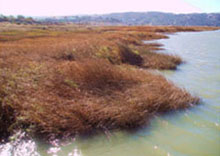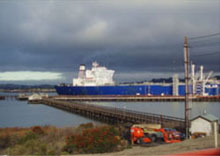Contact Pacific Southwest Waste Program
Pacific Southwest, Region 9
Serving: Arizona, California, Hawaii, Nevada, Pacific Islands, Tribal Nations
EPA Takes Action to Protect San Francisco Bay:
First Phase of Cleanup Removes 4,100 Pounds of MTBE

EPA learned in 2006 that fuel oxygenates had leaked from a refinery storage terminal and begun to migrate towards the San Francisco Bay estuary. EPA, the California Regional Water Quality Control Board, and the responsible parties mobilized immediately to control the flow and find the source.
While reviewing monitoring reports in July 2006, EPA noticed high levels of MTBE in groundwater at the Amorco Terminal in Martinez, California. MTBE was used widely as a fuel additive to gasoline during the 1990s, and had been stored at the Amorco Terminal site. EPA is evaluating the possible cancer-causing effects of MTBE, and is also concerned about its potential impact on the ecosystem. High levels of this chemical were found approximately 175 feet from the Bay at an elevation of 20 feet, and appeared to be flowing underground toward the Bay. Groundwater in this area is not used for drinking water, but EPA is concerned that MTBE could discharge into the Carquinez Straight and potentially affect the San Francisco Bay estuary system. MTBE readily dissolves in water, can move rapidly through soils and aquifers, is resistant to microbial decomposition and is difficult to remove in water treatment. MTBE concentrations at the site were hundreds of times greater than EPA's ambient water quality criteria for this contaminant.
The Carquinez Strait is a critical link in the San Francisco Bay estuary. The waters which flow through this eight-mile-long channel provide the fresh water needed to host a diverse array of flora and fauna, including the birds which migrate through the Pacific Flyway and the salmon which migrate hundreds of miles upriver to spawn. The channel has also been a crucial link in shipping for the Bay Area since the Gold Rush. Petroleum crude oil is shipped through the Strait to the Amorco Terminal for delivery to adjacent refineries.
At the time the MTBE release was identified in July 2006, the Amorco Terminal had been acquired by Tesoro Refining and Marketing Corporation. Since Tesoro did not store or manufacture MTBE at the terminal, the problem was identified as having been caused by a prior owner. Although MTBE has not been sold in California since its phase-out in 2003, MTBE contamination from historical releases is still a concern.

All parties took immediate action to address the release. EPA requested that the responsible parties install an operating cleanup system within 180 days. The San Francisco Bay Regional Water Quality Control Board made the same request, and also issued a Cleanup and Abatement Order on January 4, 2007. The responsible parties responded immediately, installing a groundwater extraction system which began operation on January 29, 2007. Almost immediately, the system was capturing significant amounts of MTBE. In the first 150 days of operation, a total of approximately 282,000 gallons of groundwater were removed by the extraction system. As a result of this process, approximately 4,100 pounds of MTBE were removed. The extraction system continues to operate effectively, capturing the highest concentration portions of the plume and blocking the source area from reaching Carquinez Strait.
Future efforts will assess the partially-submerged tidal lands at the edge of the Straight. Tesoro and the regulatory agencies intend to evaluate whether any MTBE actually reached the Carquinez Straight, and identify any necessary remedy. Meanwhile, the groundwater extraction system will continue operating into the future, and the groundwater monitoring program will continue.


